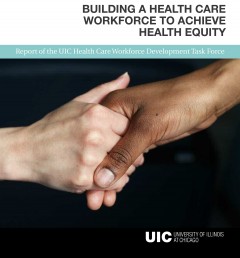UIC reflects on how it will build the health care workforce of the future
Changes come rapidly in health care, and the University of Illinois at Chicago is investigating how to lead in educating tomorrow’s health care professionals.
A new, comprehensive report, “Building a Health Care Workforce to Achieve Health Equity,” describes how UIC can better align its educational programs with the way health care will be delivered in the future. The report was produced by a multidisciplinary task force of more than 20 practitioners from UIC’s seven health science colleges.
“More health care professionals are educated at UIC than any other institution in the state,” said Dr. Saul Weiner, co-chair of the task force and vice provost for planning and programs. “It is crucial that we understand what we can and should do to ensure that UIC continues to produce the highest quality health care workforce Illinois requires.”
Part of the university’s mission is to reduce health disparities and increase access to health care services for underserved populations. The task force studied demographic factors, changes in health care delivery systems and changes in workforce supply and demand.
Experts predict that an aging and increasingly diverse population, along with implementation of the Affordable Care Act, will increase the demand for some specialties and jobs; diminish the demand for others; and create a need for some new ones, Weiner said.
After reviewing health care data, available federal and state funding for workforce development, and input from UIC’s seven health science colleges, the task force recommended that UIC:
- Identify and establish targets for existing and new programs for each college, taking into account market trends and anticipated demands
- Pursue state, federal and private funds for workforce development, particularly in the colleges of Nursing, Dentistry and Medicine; the School of Public Health; and the University of Illinois Hospital & Health Sciences System
- Continue to develop a collaborative curriculum that utilizes each discipline and creates opportunities for students from different health science colleges to train together
- Develop a diverse workforce by coordinating campus-wide programs that support underrepresented and disadvantaged minorities at the secondary and post-secondary levels through STEM (Science, Technology, Education, Mathematics) education into the health professions
- Partner with two-year colleges and other community education programs to develop health profession educational programs, particularly with underrepresented groups; develop curriculums for emerging mid-level occupations such as health care navigators, care coordinators and community health workers; and develop joint programs requiring both associate level and baccalaureate or master’s level training, such as physician assistants
- Make it a priority for the colleges to place their graduates in medically underserved areas and in primary care or subspecialty fields that are understaffed, such as pediatrics
The task force examined which of UIC’s approximately 80 degree and certificate programs in the health sciences are training students for occupations that are increasing or decreasing in demand, as reflected in wage and job growth. But it also looked at job classifications for which UIC offers no training program.
“It was important to identify jobs that are growing in demand for which UIC is not currently providing training, because these represent potential opportunities,” said task force co-chair Surrey Walton, associate professor of pharmacy systems, outcomes and policy and assistant director of the Center for Pharmacoepidemiology and Pharmacoeconomic Research. Those jobs include audiologists, community health workers, industrial-organizational psychologists, medical and health services managers, physician assistants, social and community service managers, and speech-language pathologists.
Weiner said the task force also factored in the rising cost of tuition, the burden of student loans, and the decreasing financial support from the state in making the recommendations.
“These are things that may affect students’ decisions about which, if any, healthcare professions to pursue,” he said.
